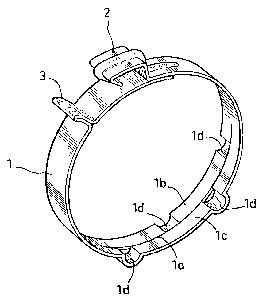Some of the information on this Web page has been provided by external sources. The Government of Canada is not responsible for the accuracy, reliability or currency of the information supplied by external sources. Users wishing to rely upon this information should consult directly with the source of the information. Content provided by external sources is not subject to official languages, privacy and accessibility requirements.
Any discrepancies in the text and image of the Claims and Abstract are due to differing posting times. Text of the Claims and Abstract are posted:
| (12) Patent: | (11) CA 1310475 |
|---|---|
| (21) Application Number: | 1310475 |
| (54) English Title: | METAL CLAMP |
| (54) French Title: | BRIDE METALLIQUE |
| Status: | Expired and beyond the Period of Reversal |
| (51) International Patent Classification (IPC): |
|
|---|---|
| (72) Inventors : |
|
| (73) Owners : |
|
| (71) Applicants : |
|
| (74) Agent: | MARKS & CLERK |
| (74) Associate agent: | |
| (45) Issued: | 1992-11-24 |
| (22) Filed Date: | 1988-06-14 |
| Availability of licence: | N/A |
| Dedicated to the Public: | N/A |
| (25) Language of filing: | English |
| Patent Cooperation Treaty (PCT): | No |
|---|
| (30) Application Priority Data: | ||||||
|---|---|---|---|---|---|---|
|
ABSTRACT OF THE DISCLOSURE
This invention relates to a clamp constituted
by a metal band wound on itself, comprising complemen-
tary tightening and/or joining means in the vicinity
of each of its ends. The band presents, in a zone
preferably remote from said ends, a longitudinal
slit thus defining two band sections, parallel and
contiguous with respect to each other. On each of
said band sections is provided at least one corruga-
tion projecting outwardly of the clamp, each corruga-
tion of one of the band sections being offset circum-
ferentially with respect to each corrugation of the
other band section.
Note: Claims are shown in the official language in which they were submitted.
Note: Descriptions are shown in the official language in which they were submitted.

2024-08-01:As part of the Next Generation Patents (NGP) transition, the Canadian Patents Database (CPD) now contains a more detailed Event History, which replicates the Event Log of our new back-office solution.
Please note that "Inactive:" events refers to events no longer in use in our new back-office solution.
For a clearer understanding of the status of the application/patent presented on this page, the site Disclaimer , as well as the definitions for Patent , Event History , Maintenance Fee and Payment History should be consulted.
| Description | Date |
|---|---|
| Time Limit for Reversal Expired | 2008-11-24 |
| Letter Sent | 2007-11-26 |
| Inactive: IPC from MCD | 2006-03-11 |
| Grant by Issuance | 1992-11-24 |
There is no abandonment history.
| Fee Type | Anniversary Year | Due Date | Paid Date |
|---|---|---|---|
| MF (category 1, 5th anniv.) - standard | 1997-11-24 | 1997-10-15 | |
| MF (category 1, 6th anniv.) - standard | 1998-11-24 | 1998-11-02 | |
| MF (category 1, 7th anniv.) - standard | 1999-11-24 | 1999-10-19 | |
| MF (category 1, 8th anniv.) - standard | 2000-11-24 | 2000-10-31 | |
| MF (category 1, 9th anniv.) - standard | 2001-11-26 | 2001-10-22 | |
| MF (category 1, 10th anniv.) - standard | 2002-11-25 | 2002-11-12 | |
| MF (category 1, 11th anniv.) - standard | 2003-11-24 | 2003-10-17 | |
| MF (category 1, 12th anniv.) - standard | 2004-11-24 | 2004-10-20 | |
| MF (category 1, 13th anniv.) - standard | 2005-11-24 | 2005-10-18 | |
| MF (category 1, 14th anniv.) - standard | 2006-11-24 | 2006-10-18 |
Note: Records showing the ownership history in alphabetical order.
| Current Owners on Record |
|---|
| ETABLISSEMENTS CAILLAU, SOCIETE A RESPONSABILITE LIMITEE |
| Past Owners on Record |
|---|
| LIONEL CALMETTES |
| MICHEL ANDRE |